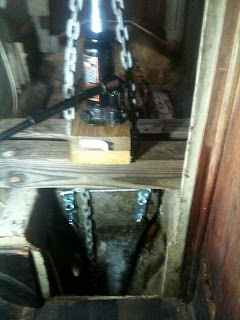
Between August and early January, the following work was completed. Work was sporadic for a variety of reasons. Altogether, I spent about 90 hours, unassisted, throwing things out, pumping tanks, removing the engine and mechanical systems, removing things to gain access for inspections, cleaning, doing inspections. Primary tools used were screwdrivers (manual and electric), wire cutters, a sharp knife, a reciprocating saw, and SAE and metric wrenches.
All of the loose items were removed from the boat.
The water was all out of the bilge, fuel pumped from the fuel tank (the fuel was, surprisingly, very, very clean, with no water in the fuel, indicating that the fuel tank is intact), and potable water tanks drained. The tank has some severe pitting corrosion on its top, and I will replace it while the boat is torn apart since it will likely corrode rapidly due to the salt water in the foam adjacent to the tank.
Mast, boom, spreaders, and standing rigging and terminals were fine at preliminary inspection. The mast and boom fittings need to be removed, some corrosion dealt with, and the spars repainted. I flushed the standing rigging with fresh water, and sprayed it, especially the turnbuckles and end fittings, repeatedly with WD-40. Existing running rigging was inspected, washed in fresh water, and is fine. The sail suite is good to excellent, with only a few seasons wear, and older spare sails are fair to good.
I removed all the overhead liners to expose the underside of the deck for inspection since they were all damaged and mildewed. I removed the teak pukas on the cabin sides in the forepeak to allow all the paneling strips on the cabin sides in the main cabin to be removed to gain access to chain plates. I removed the rotting carpet from the aft cabin sides. There was little evidence of the wood deck house core having been wetted. There was no evidence that the port lights have leaked past their bedding or seals.
I ripped out all of the electric system except for the wiring that is embedded in the cabin top for interior lighting. I removed the minor hardware throughout the boat that was used for hanging miscellaneous items. I removed all cabinet doors and associated hardware. I washed down the boat interior with fresh water, brushing all surfaces to remove salt residue.
I removed the engine and transmission, and the exhaust system. The exhaust hose wire was rusted and the hoses required replacement. The shaft coupling was heavily rusted, and the shaft end inside the coupling is rusted as well. Both will need replacement. The shaft is snug in the cutlass bearing, so the bearing is probably fine. The rudder is a bit loose in the gudgeons and pintles. I removed the Cold Machine refrigeration unit which had been located high in the footwell of the starboard bunk in the aft cabin on a plywood platform. The bunk plywood under the machine is in bad shape because the machine sweated and water dripped in that area during use.
Many of the boat's systems are long overdue for overhaul. Hoses for all plumbing were dry and brittle, and internal wire in cockpit drain and exhaust hoses was rusted and weakened. I removed it all. The boat had no head or holding tank plumbing, only a portable toilet. It was, of course, removed and discarded.
All exterior brightwork was long overdue for attention. It has some pretty deep grooves due to weathering, and must be sanded and heavily oiled to restore it. All hatches need rebuilding. Teak handrails on the cabin top are weakened, and bronze fasteners are corroded and brittle. Teak rub/trim strips on the cabin sides need replacement. Teak cap rails are damaged in a couple of places and new teak will have to be "let in" to replace sections.
The rudder cheeks, tiller, and bow platform are all in good shape, needing only cosmetic attention. Stainless steel lifelines are rusted and the wire is brittle. Two stanchions were bent when the boat was re-floated, and the gelcoat has been crazed at the foot of one of the bent stanchions. I will need to inspect this area further. The bow and stern pulpits have minor surface corrosion. The boom gallows frame is fine, and the gallows wood needs attention. The aft starboard chainplate was bent slightly during re-floating. The fwd and aft starboard chainplates have micro-cracks at one carriage bolt hole on each of the chainplates.
All running lights except the tri-color masthead light are damaged/corroded beyond repair.
The mast tabernacle is in great shape.
I removed numerous topside fittings that obviously needed re-bedding.
I ripped out all of the cabinetry on the starboard side of the main cabin from the ice box to the companionway. It was all damaged...delaminating between plies. This area included the ice box (the top of which had been modified to accept a double burner alcohol/electric stove), double SS sinks, and the refrigerator. The stove was not salvageable.
All through hull fittings were given a preliminary inspection. They all need to be re-worked, because they are were not installed with sea cocks, but with in-line ball valves installed on the thru hull fittings, NPS threads to NPT threads.
-






































